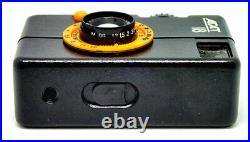
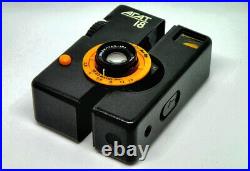

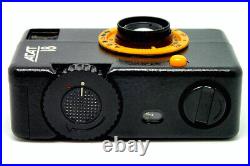
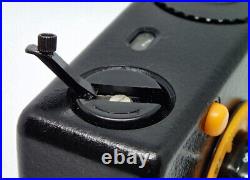
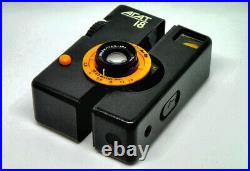
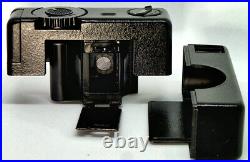
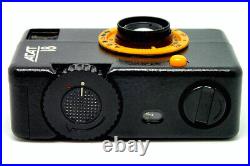
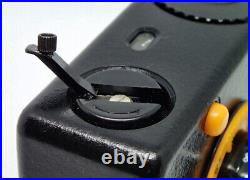
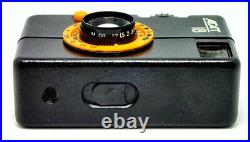









Agat-18 was produced at several BelOMO enterprises from 1984 to 1989. The Agat line consisted of only two devices, the second was Agat-18K. Why did the device immediately receive an index of 18? I would venture to suggest that this is from the size of the short side of the frame 18 mm, i. The index covertly indicates that the device is half-frame. A semi-format camera is a camera designed for a standard 35 mm film, but displaying half the size of frames on it. Not 24×36 mm, but 24×18. It is quite unusual, although it is quite obvious that the horizontal position of the frame in a half-format device is achieved with the vertical position of the camera itself. The advantage of this concept is the fact that it is possible to fit not 36, but 72 frames on a standard film. In the USSR, from the 60s to the end of the 80s, in general, many models of semi-format devices were produced. All photo companies had their own models. Arsenal, except that, having a miniature Kiev-30 and the like, did not release semi-formatters. I think I will not be mistaken if I say that the Belarusian production association BelOMO distinguished itself with the greatest variety of cameras of this class. We will consider one of the BelOMO devices today. It will be Agate-18. Probably, Agat-18 is a semi-format device that was produced later than all others, right up to 1989. Why did I start at the end of the story? Yes, it just happened.. Before Agat, a line of semi-format Chaika devices was produced at BelOMO for a long time. We’ll look at them later. There were several models in the lineup. The line has existed for about 10 years, the Chaika camera of various modifications was popular and its production is measured in millions of pieces. The final model even had a built-in exposure meter. But around the mid-70s, the Seagull line was turned down and after a solid break, in the 80s already, the concept of semi-format devices poured into BelOMO in Agat-18. Agate-18 is a peculiar apparatus. At the same time, the camera turned out to be light, compact, and inexpensive. A kind of Soviet soap dish. I would venture to suggest that by the beginning of the 80s the logic of saving on film (72 frames versus 36) had completely outlived its usefulness. Therefore, the point in creating complex and technologically advanced semi-format cameras, such as Narcissus (which, not only was a reflex camera, but also had a fleet of interchangeable optics), disappeared. The new logic was that a half-frame camera is a tool either for a beginner (not even for a beginner, but for a person who generally wants to bother minimally in the whole photo kitchen, he just needs pictures), or a tourist who cares about every gram of weight saving and who in general does not smile at the most inopportune moment to look for a spare roll of film in a backpack. The same Chaika, for example, was only slightly inferior in size to the Smena-8M. The device was sharpened under this logic. The design was simplified so much that the camera does not even open, but simply falls apart into 2 halves. The shutter was combined with the diaphragm. The exposure setting was reduced to weather symbols. But, I loaded the film once and then shoot without being distracted. Photos in those days were not stored on HDD, but in albums. For this method, 72 frames is really a lot. And it is not hard to carry the device and it fits in your pocket. Even the lens cap is streamlined to avoid clinging to anything. And it will be lost – not particularly sorry for the camera itself – only the pictures. Agatha’s price was not very high. Fixed lens Industar-104 2.8 / 28. I would like to rejoice at the wide-angle lens, but, alas, it will not work. Agate-18, this is in a modern manner – a crop. For a 24×18 frame, the 28mm FR is a normal lens. The shutter is a central two-lobe. If necessary, the shutter does not open completely, thereby performing the function of the diaphragm. The shutter speed changes smoothly from 1/60 to 1/250, including intermediate values. Shutter speed B is absent. Available apertures range from f2.8 to f16. Exposure control of Agatha-18 is reduced to movement along a single program, in which shutter speeds and apertures are switched synchronously in pairs smoothly in strict sequence and this order cannot be changed. The device is equipped with a flash bracket with a central contact and a tripod socket, but lacks a self-timer. The weight of my copy is 120 grams. The body of the device is made of plastic resembling bekalite. Although the plastic is slightly textured, it is noticeably slippery to the touch. Agat-18 is designed mainly for shooting with a vertical body position. When describing the panels (top, bottom, right, left), I will focus on the orientation of the title label. There are 2 rings that control exposure. The rings are colored orange. Below and to the right is a small shutter button. She is also orange. Top left – a rectangular viewfinder eye. One of the internal lenses of the viewfinder is unexpectedly orange coated anti-reflective? , Which makes the viewfinder rather bright orange. It looks very modern. All these bright blotches on the charcoal-black body make Agat-18 not devoid of style. To Europe – about 1-2 weeks. To the USA and the rest of the world – about 2-4 weeks. This means that they are working, but old (from 30 to 80 years old). This item is in the category “Cameras & Photo\Vintage Movie & Photography\Vintage Cameras\Subminiature Cameras”. The seller is “okskarb0″ and is located in this country: UA. This item can be shipped worldwide.
- Brand: Agat
- Series: 18
- Format: Half-frame 35mm (18×24)
- Custom Bundle: No
- Color: Black
- Model: Agat-18
- Country/Region of Manufacture: Ukraine
- Modified Item: No
